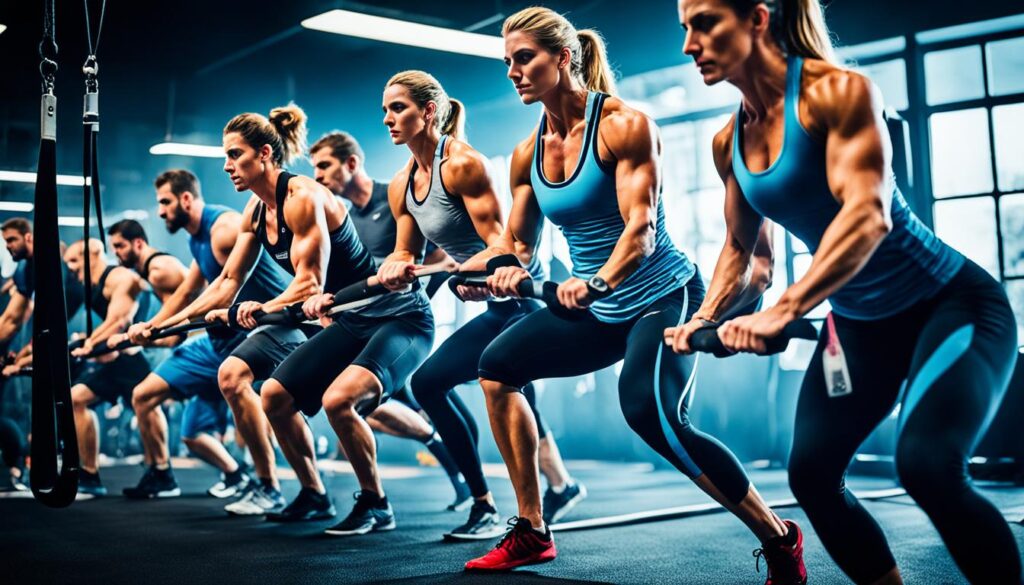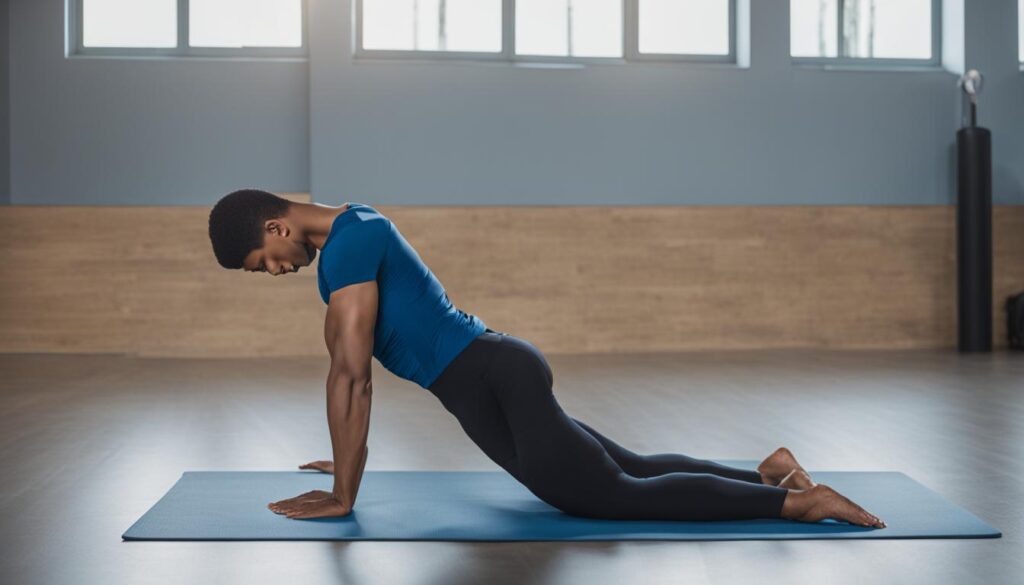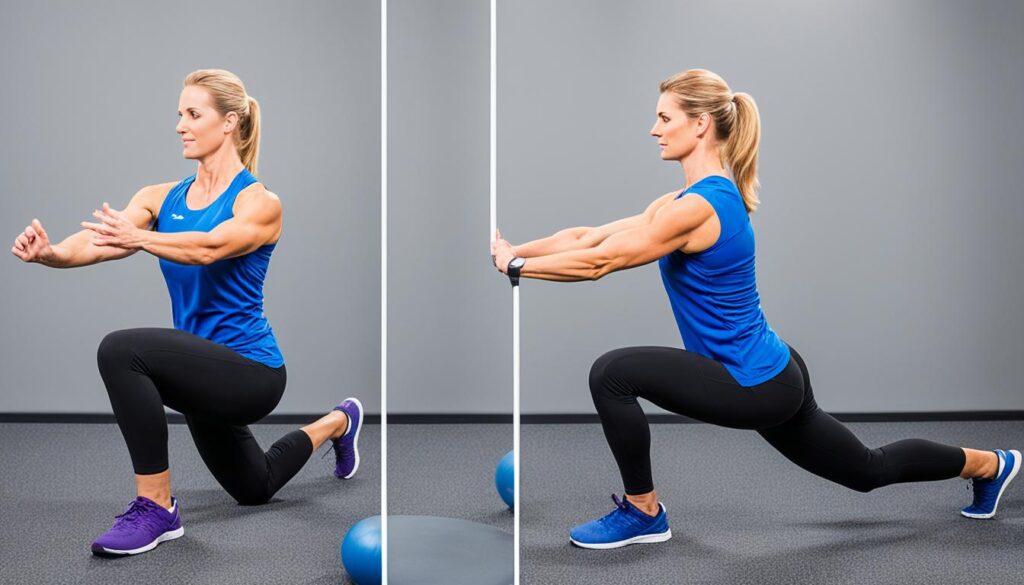Do you feel frustrated by frequent injuries during your workouts? Are you looking for exercises to make your injury-prone areas stronger and more resilient? You’re in the right spot! This article will discuss the top exercises to strengthen your body and keep injuries at bay. They are great for athletes and anybody wanting to stay in shape. These exercises will boost your performance and help you stay free from injuries.

Key Takeaways:
- Strength training and cardiovascular endurance are crucial for injury prevention.
- Exercises like push-ups, pull-ups, squats, running, swimming, and cycling can enhance strength and endurance.
- Flexibility and mobility exercises improve range of motion and reduce the risk of injuries.
- Weight training aids in rehabilitation, muscle recovery, and overall strength building.
- Progressive overload and safe implementation are key to building resilience and preventing injuries.
Importance of Strength Training in Injury Prevention
Strength training is key for preventing injuries and boosting overall fitness. It focuses on muscle strength to enhance athlete performance. This lowers the chance of getting hurt.
Exercises like push-ups and squats build strength in areas often injured. This makes athletes’ bodies stronger and less likely to face injuries. Core stability gets better too, helping with form and balance.
Regular strength training boosts fitness and the ability to handle sports demands. It betters muscle performance and coordination. Athletes then perform their best with less injury risk. Mixing strength training with cardio makes a full fitness plan for injury prevention and top-notch performance.
| Benefits of Strength Training in Injury Prevention |
|---|
| Improves muscle strength |
| Enhances muscle endurance |
| Reduces the risk of injury |
| Enhances core stability |
| Improves overall fitness |
All training programs should have strength training, for athletes or fitness enthusiasts. It targets different muscles and increases resistance over time. This leads to better injury prevention and muscle growth.
It’s smart to talk to a fitness pro before starting strength training. They help ensure you’re doing exercises right. Their advice on a tailored program reduces injury risk and meets your goals.
The Role of Cardiovascular Endurance in Injury Prevention
Cardiovascular endurance is key in preventing injuries for athletes in intense sports. It lets athletes keep up a high level of activity without tiring out quickly. They can boost this endurance by doing activities like running, swimming, and cycling.
Adding bodyweight exercises such as squats and lunges is also helpful. These exercises strengthen the lower body. This is crucial for staying stable and avoiding injuries when moving fast.
Cardiovascular fitness can be checked by doing tests like the Cooper Test and VO2 Max test. These tests show how well an athlete can exercise intensely. They offer useful info about their cardiovascular endurance.

Improving your cardiovascular fitness is vital, no matter if you’re an athlete or just want to avoid injuries. It plays a big role in staying safe and performing well in sports.
The Benefits of Cardiovascular Endurance in High-Intensity Sports
High-intensity sports push athletes to their limits for longer times. Without good cardiovascular endurance, athletes might get tired quickly. This can hurt their performance and up the chance of getting injured.
Boosting cardiovascular endurance lets athletes:
- Keep performing well during a long game or contest
- Recover faster after intense activity
- Build more stamina and endurance
Building up cardiovascular endurance lowers injury risks. It also helps athletes do their best when it counts.
The Role of Cardiovascular Endurance in Injury Prevention
Cardiovascular endurance is crucial for preventing injuries. It makes an athlete fitter and more durable. With better endurance, athletes can avoid getting hurt from being too tired.
In high-intensity sports like soccer, basketball, and tennis, it helps athletes stay sharp and flexible. This lowers the chance of making mistakes that could cause injuries.
“Improving cardiovascular endurance is like making your body’s engine stronger. A strong engine works better and is less likely to have problems.”
– Dr. Lisa Johnson, sports medicine specialist
By focusing on cardiovascular endurance, athletes can get stronger and avoid injuries. This helps them give their best performance.
| Cardiovascular Exercises | Benefits |
|---|---|
| Running | – Improves cardiovascular fitness – Enhances leg strength and endurance |
| Swimming | – Builds cardiovascular endurance without impact on joints – Engages the entire body |
| Cycling | – Increases cardiovascular fitness – Strengthens leg muscles |
| Bodyweight exercises (squats, lunges) | – Complements cardiovascular exercises for overall strength and stability – Builds leg and core strength |
The Importance of Flexibility in Injury Prevention
Flexibility is key to preventing injuries. It’s about how much our muscles and joints can move. By getting more flexible, athletes can lower their chance of getting hurt. This is because they won’t strain as much. Dynamic stretching, yoga poses, and mobility drills are great for this.
If an athlete isn’t very flexible, they move stiffly. This ups their risk of getting hurt. The more flexible an athlete is, the safer they are when they’re active, like when running.
Being more flexible stops muscle imbalances that cause injuries, too. It leads to smoother movements, which lowers strain risks.
The Benefits of Flexibility in Injury Prevention
- Lower chance of muscle strain: Better flexibility means muscles and tendons stretch more. So, they’re less likely to get strained or tear.
- Healthier joints: Doing exercises that make you more flexible helps your joints move better. This lowers the chance of hurting your joints.
- Better posture: Training for flexibility fixes muscle imbalances and aligns your body. This can make your posture better and reduce back and neck injuries.
- Faster recovery: If your muscles are flexible, they heal faster from workouts or injuries. This means athletes can return sooner, with less downtime.
Good flexibility doesn’t just lower injury risks. It also makes athletes perform better. They have more agility, balance, and coordination. This gives them an edge in competitions.

Yoga, Pilates, and stretching routines are good for staying flexible. Incorporating flexibility exercises into your exercise plan helps a lot. It keeps you from getting injured and boosts your sports performance.
Rehabilitation and Strengthening through Weight Training
Weight training is great for fixing muscles and getting stronger. It uses careful exercises to help healing. It focuses on injured muscles, making them stronger and more flexible.
It’s not just about healing. Weight training also makes you overall stronger and more stable. Always use the right form and work with experts for the best results.
Training this way helps muscles recover faster and stops new injuries. You slowly do more intense exercises. This helps get your strength and flexibility back.

Always do weight training with a professional’s help. They make sure what you do fits your needs and goals. Done right, it can really change your recovery for the better, making muscles stronger and more useful.
Building a Foundation of Strength for Injury Prevention
Strength training is vital for creating a strong support system. It helps prevent injuries. Focusing on primary muscles and stabilizers improves posture and balance.
Squats, lunges, and push-ups are great for working many muscles at once. These exercises provide balanced growth. They make you stronger and more stable.
A strong base helps avoid falls and injuries. It’s crucial to also work on smaller muscles that stabilize joints. This method ensures a reliable support system during intense activities.
Adding strength exercises to your routine builds a solid base. This improves your performance and makes you resilient.

“Building a solid support structure through strength training minimizes the risk of injury during vigorous physical activities.”
Strengthening main muscles and stabilizers is key. Exercises like squats, lunges, and push-ups work many muscles. This balanced development reduces injury risks, supporting your performance.
Table: Exercises for Building a Solid Support Structure
| Exercise | Targeted Muscle Groups |
|---|---|
| Squats | Quadriceps, Hamstrings, Glutes, Core |
| Lunges | Quadriceps, Hamstrings, Glutes, Calves |
| Push-ups | Chest, Triceps, Shoulders, Core |
By adding these exercises to their workout, athletes can build a strong base. This boosts performance and lowers injury risks.
Enhancing Flexibility and Mobility for Injury Prevention
Adding flexibility and mobility workouts to your routine is key for avoiding injuries. These exercises make your joints move better, lower injury risks from stiffness, and boost your overall performance.
Dynamic stretches, yoga, and mobility drills can greatly improve your flexibility and joint movement. They complete your strength workouts by making your muscle and joint actions smooth and coordinated.
“Flexibility is not only about your body; it’s also a way of thinking. Start the journey to unlock your body’s potential with regular flexibility training.” – Anne Smith, Yoga Instructor
Keeping or boosting your range of motion helps you avoid injuries when active. Being more flexible can also stop muscle imbalances. This leads to easier and smoother movements.
Dynamic Stretching
Dynamic stretching uses active moves to warm up and stretch your muscles at the same time. It boosts flexibility, increases blood flow, and gets your body ready for more intense activities. Add exercises like leg swings, arm circles, and hip rotations to your warm-up.
Yoga Poses
Yoga does more than increase flexibility. It also strengthens muscles, improves balance, and focuses your mind. Try poses like downward dog, warrior, and pigeon to stretch key muscles and better your joint movement.
Mobility Drills
Mobility drills work on particular joints and muscles to enhance their flexibility and movement. Do exercises like shoulder dislocations, hip openers, and ankle circles to boost your mobility and keep injuries away.

Make sure to add flexibility and mobility exercises to your workouts routinely. They help you perform at your best, lower injury risks, and meet your fitness aims. Start slow, listen to what your body says, and gradually challenge yourself more.
Building Resilience through Progressive Overload
Progressive overload is key to becoming more resilient. By slowly upping exercise intensity, athletes cause their bodies to adapt. This not only boosts performance but also lowers injury risks, readying athletes for future hurdles.
To fully build resilience, consider mindfulness, stress handling, good eating, and enough rest. These components unite to forge a tough body and mind. They help in facing obstacles and bouncing back quickly from tough times.
Progressive Overload Explained
To employ progressive overload, increase your body’s exercise demands gradually. This can mean lifting more weight, doing more reps, exercising longer, or ramping up intensity.
“Progressive overload is like adding an extra hurdle to a race. Each time you overcome it, you become stronger and better prepared for the next challenge.”
This challenge makes athletes stronger and more equipped to handle stress. It taps into the body’s ability to adapt and toughen up.
Benefits of Progressive Overload
Training with progressive overload has many perks:
- Increased strength and muscle growth
- Improved cardiovascular health
- Better endurance and stamina
- Lower injury risk
It also builds mental toughness. It encourages athletes to push their boundaries and break through personal barriers.
Implementing Progressive Overload Safely
Start with manageable challenges to avoid strain. Slowly heighten these challenges, giving your body time to adjust and heal. Focus on doing exercises correctly to prevent harm and get the most benefit. Don’t forget to rest, as it’s crucial for recovery and growth.
- Start with a weight or intensity level that challenges you without causing excessive strain or discomfort.
- Gradually increase the demands over time, allowing your body to adapt and recover between sessions.
- Pay attention to proper form and technique to prevent injuries and maximize the effectiveness of the exercises.
- Include rest days in your training schedule to allow for recovery and muscle growth.
Key Takeaways
Progressive overload is vital for resilience. It encourages the body to adapt, enhancing performance and reducing injury risks. Don’t forget the importance of mindfulness, stress management, nutrition, and rest for best results. Accept the challenge, push beyond your limits, and watch as you grow stronger and more resilient.

Implementing Weight Training Safely and Effectively
It’s key to start weight training the right way. This means preventing injuries, getting stronger, and building resilience. Work with pros, like healthcare experts or certified trainers. They tailor advice to your personal fitness goals and health status.
Starting slow is important in weight training. Increase your workout’s intensity bit by bit. This lets your body get stronger safely, avoiding harm. Begin with small weights. Then add more as you feel stronger. This is the best way to progress.
Keeping the right form is crucial. Good form activates the right muscles and keeps joints safe. This lowers the chance of getting hurt. Learn the correct way to do each move. Pay attention to how you stand, align, and move. A trainer’s eye can ensure you’re doing it right.
Listening to your body is essential when lifting weights. Notice any pain or discomfort. Pushing through pain can cause injuries. If something feels wrong, it’s smart to stop and ask a pro. Rest days are vital too. They help your body heal and get stronger.
Seeing weight training as a journey is wise. This journey should be safe and suit your abilities. Keep safe, progress slowly, maintain correct form, and listen to your body. This way, weight training brings benefits without the risk of injuries.

Importance of Fitness for First Responders
Fitness is key for first responders like firefighters, police officers, and emergency medical technicians. They need physical strength, agility, and mental sharpness for their demanding jobs. It’s vital they include the right exercises in their workouts to stay at the top of their game and avoid injuries.
A good fitness routine for them includes exercises made just for their needs. Foam rolling helps ease muscle tension and boosts mobility. Active warm-ups get the body ready for what’s coming. And, exercises like deadlifts and functional dumbbell moves work out important muscles and copy the actions they do at work.
High-intensity interval training (HIIT) also plays a big part in boosting their fitness. HIIT is all about quick, intense exercise spurts followed by short recovery times. Adding these exercises to their routine helps first responders get better at their jobs. They gain endurance, strength, and focus, making them ready to face anything while keeping safe.
FAQ
What are the best exercises for strengthening injury-prone areas and enhancing resilience?
Why is strength training important in injury prevention?
What is the role of cardiovascular endurance in injury prevention?
How does flexibility contribute to injury prevention?
How can weight training aid in rehabilitation and muscle recovery?
How can building a foundation of strength prevent injuries?
How can flexibility and mobility exercises contribute to injury prevention?
What is the importance of progressive overload in building resilience?
How can weight training be implemented safely and effectively?
Why is fitness important for first responders?
Source Links
- https://www.americansportandfitness.com/blogs/fitness-blog/building-resilience-how-fitness-can-shield-you-from-injuries
- https://medium.com/@KeciaKellyLegacyHealth/from-rehabilitation-to-resilience-weight-training-for-injury-prevention-and-recovery-820fc5468a48
- https://www.ems1.com/wellness-week/my-top-5-exercises-for-every-firefighter-paramedic-and-emt